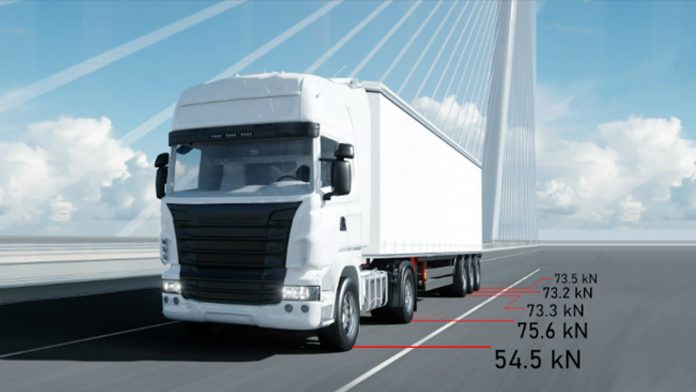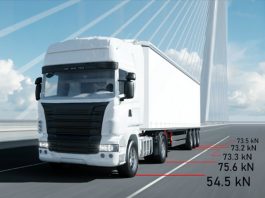Although there are fewer categories of heavy goods vehicles in Asia than Europe, the vehicles themselves are far less uniform – this is where PSP’s iBWIM system comes into play.
Bridge weigh-in-motion (BWIM) is a technique for weighing heavy goods (HG) vehicles as they cross a bridge. By combining it with machine learning techniques, it is possible to categorise vehicles. This gives useful physical and business intelligence for the management of the bridge.
Our clients wished to assess the economic value of their bridge and the damage inflicted by HG traffic. They also wanted the ability to intervene either by signage or by forcing the vehicle to stop. Our clients needed a system that measured the weight and class of HG vehicles as they passed over the bridge–without stopping or impeding the vehicle. Just as importantly, they needed a system that could be installed without disrupting traffic flow.
Bridge Weigh in Motion
BWIM systems measure the weight distribution of a HG vehicle as it traverses a bridge by measuring the deformation of the bridge. The vehicle is not stopped, and traffic flow is undisturbed. Crucially, unlike conventional weigh in motion systems which must be embedded in the road surface, BWIM systems are installed on the underside of the bridge. This means they can be installed without lane closures or traffic disruption and have almost no impact of the structure of the bridge.
PSP’s iBWIM system is implemented in two parts: a robust, cluster of lightweight embedded systems on site and a remote server that processes the measurements. The on-site systems monitor the sensors, perform pre-processing and pass the data to the remote server. An embedded system requires much less on-site infrastructure that a PC based system. In fact, because iBWIM can run from a battery and solar cell for several weeks, the only infrastructure required is mobile network coverage.
The on-site embedded system connects to the remote server over a GSM link. The remote server performs the bulk of the signal processing and analysis. We are therefore able to use complex, computationally intensive data analysis algorithms and to quickly and easily optimise their settings for a given bridge.
The server also handles data presentation. The customer can access the data and compile statistics with a secure, easy to use web page. PDF reports that are tailored to the customer’s requirements can be periodically compiled. When a vehicle passes over a bridge, an event is reported to the server. How the event is processed depends on whether the aim is to model traffic flow, or the damage caused by heavy goods traffic on the bridge. If structural damage is the primary concern, the frequency and severity of axle impacts, and bridge harmonics must be quantified. The cumulative effect of these impacts is integrated into the bridge damage model.
Applying iBWIM
The aim of this project was to take our existing iBWIM system, which has successfully been used in Europe, and apply it in an East Asian environment. Furthermore, we would develop additional software to classify heavy goods vehicles into one of 25 categories based on their weight and axle distribution.
Although iBWIM had been used extensively in Europe, deploying it in an Asian context would not prove to be straightforward. Weather conditions are one factor, with daily near torrential rain disrupting our laser axle detectors. Although there are fewer categories of heavy goods vehicles in Asia than Europe, the vehicles themselves are far less uniform. Finally, the target bridge was subject to significant harmonics which affected our deformation measurements.
To deal with these problems, we completely rewrote the axle detection routines and added an additional signal processing module to suppress bridge harmonics. Tailoring the resulting code to the target bridge, improved the accuracy of the axle count from around 70% to above 95%. The additional signal processing module dramatically reduced presence of bridge harmonics in our measurements, improving the estimation of vehicle speed and simplifying the computation of vehicle weight.
The category to which a HG vehicle belongs is (at least in theory) is determined by its weight and axle distribution. In practice, measurement uncertainty and inaccuracy means that a rigid set of rules performs poorly. As a compromise between a rule based classifier and a probabilistic approach, we opted for a random forest classifier. This allowed us to incorporate the category rules specified by our customer with other ad hoc cues to produce a robust classifier. We found that various other additional factors were found to improve the classification. These ranged from vehicle speed to the day of the week and the time of the day at which the bridge crossing occurred. The rule-based and the ad hoc cues were used to build a classifier that successfully classified more than 90% of HG vehicles.
The advantage for our clients was a much clearer view of the traffic that crosses their bridge. The weight and class of an HG vehicle determine its physical effect on the bridge. When a vehicle crosses a bridge, it loads the bridge at each of its axles – viewed from a single point on the bridge, it is loaded by a series of impulse functions as the axles pass overhead. The amplitude and frequency of these impulse determines the damage the vehicle inflicts on the bridge. From a business point of view, the classes of HG vehicles crossing a bridge give strong indications about the economic activity that the bridge traffic represents, therefore the economic value of the bridge.
Dr Markus Petschacher
CEO
PEC – Petschacher Consulting, ZT-GmbH
+43 4276 33780
office@petschacher.at
www.petschacher.at/
Please note, this article will also appear in the first edition of our brand new quarterly publication. Subscribe here for all the exciting news updates.









